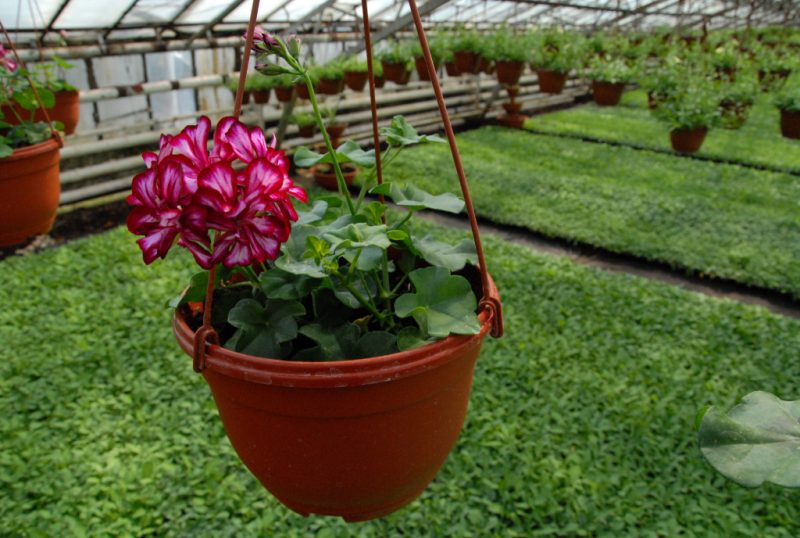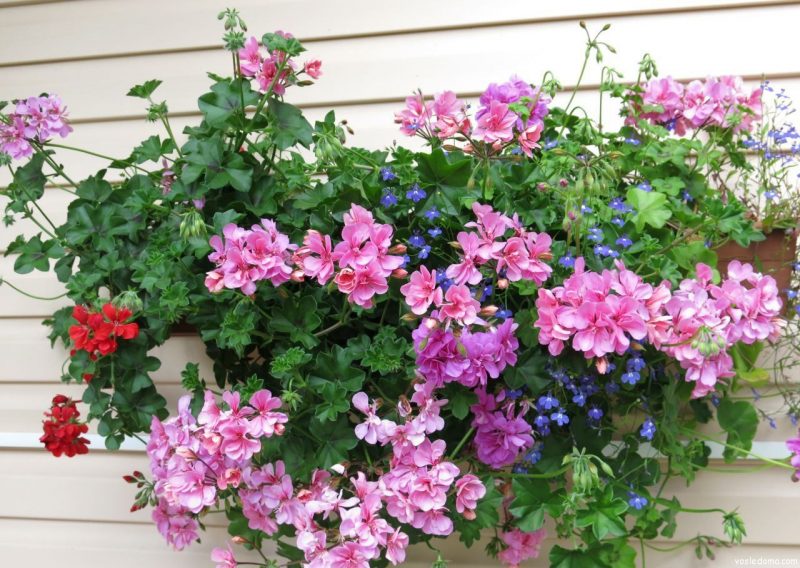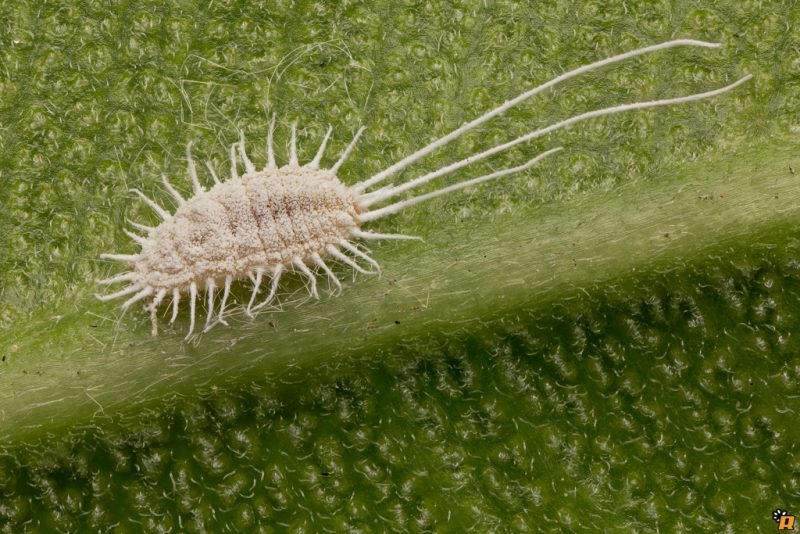Unlike the usual zonal, ampel geranium looks more beautiful in hanging flowerpots, and many colors form on it. This perennial plant is easily propagated by cuttings, does not require complex care and blooms all summer.
Material Content:
Ampel geranium: types, varieties and their description
The ivy Ampelian geranium appeared in the culture a long time ago, three centuries ago. During this time, flower growers bred many beautiful varieties that differ in the length of the shoots, the color of leaves and flowers. The shape of the corollas can be very unusual and beautiful. Sometimes they resemble small roses, bizarre alstroemeria or bright tulips.

Description of popular varieties:
- Crocodile. The variety is distinguished by the original coloring of the leaves, yellow veins are clearly visible on a green background. The flowers are coral red.
- Icerose. Corollas in appearance resemble roses. Coloring is white with a gentle pink tint.
- "Martin". Bushes grow lush, with long shoots. Terry flowers, whisk painted in lilac or pink.
- "Amethyst". Long ampoule shoots are decorated with inflorescences of large double flowers of dark pink color.
- Jackie Gold. The variety is interesting in that during flowering it changes the color of flowers from white to pink or purple.
- "Roulette". Unusual bright flowers resemble alstroemeria, white petals on the edges are painted in bright red color.
- "Rhapsody". Lush ampel bush that blooms with bright, maroon inflorescences.
All varieties of ampelous geraniums are developing rapidly.Florists sometimes plant different varieties of plants in one pot so that the flowers are of different colors and look even more decorative.
Breeding methods
For the propagation of ampelian geraniums, two methods are used - sowing seeds and cuttings. Each of them has its own characteristics, but propagation by cuttings is easier.
Cuttings
To grow ampelous geraniums from cuttings, a uterine two-year bush with lignified branches is used.
- The shank is broken off with hands, a piece of bark from the mother plant should remain on it.
- All the lower leaves of the cuttings are cut, leaving only the top.
- The prepared cuttings are placed in a substrate of peat and perlite. The volume of the landing tank should be at least 400 ml, drainage holes are mandatory at the bottom. Rooted branches in the water is undesirable, they can rot.
A young bush of pelargonium is cut in a different way.
- Cut off the tip 1 cm below the knot.
- The peduncle is removed, the lower leaves are cut.
- Do not use rooting agents, as this will slow down the development of the cuttings.
- The slice is not dried. Place the cut branch immediately in a light nutrient substrate of peat and perlite (10%) or vermiculite.
- Humidify the soil from a spray bottle.
- Make a greenhouse out of a bag or can to maintain high humidity.
- When the stalk is rooted, the shelter is removed.
Seed way
Ampelic pelargonium can be successfully propagated by seeds.

- For better germination, the seeds are pre-soaked in a Baikal solution.
- They are laid out on the surface of the soil at a distance of 2 cm and 3-4 cm between the rows.
- Then recessed into the soil by 0.5 cm, sprinkled with earth or sand.
- Humidify from a spray bottle, cover with a film and put in a bright place.
Shoots appear on the 5-6 day. Pelargonium is dived about 20 days after sowing.
- Planted in pots with a diameter of 9 cm and a volume of 200 ml. The soil should be light, with a peat content of at least 50%.
- From a common bowl, seedlings are planted in separate containers together with a lump of earth, so as not to damage the roots.
- Watered with a rooting agent.
- They put on a windowsill with diffused light and an air temperature of about 18 - 20 ° C.
- After 2 weeks, you can feed the seedlings with Radipharm.
How to choose the right container for growing
Plants grown from seeds and dived into pots with a diameter of 9 cm cannot be kept in a small container until flowering - they will develop poorly. Therefore, about a month after the first dive, seedlings are planted in pots with a diameter of 14 cm.

In the summer, a developed pelargonium seedling feels good in a flowerpot with a volume of 5 liters with several drainage holes.
Adequate soil volume is important for pelargonium. If the roots have little space, the plant can drop leaves.
The soil for planting is bought with a special “For Pelargonium”, it should be light, nutritious, well pass moisture and air. After transplanting geraniums, it is watered the next day. This is done in order to dry the damaged roots, and the plant is better taken root.
Home care and growing
A plant bought in a store must be treated with fungicides and insecticides against insect pests and fungal infections. Quarantined for 2 weeks, separate from other colors.

In order for the ampelous geranium to maintain its beautiful appearance, it is necessary to make regular top dressing 2 or 3 times a month. You can use humic fertilizers.
It is advisable to reduce the number of shoots on a lush bush, purchased pelargonium, so that it is easier to grow.
Cut cuttings can be rooted and new plants grown.
With proper care, the flowering of ampelous geraniums continues throughout the warm season until October. The soil should not be constantly moist, regular watering alternate with drying the top layer.
Pelargonium must be placed in a sunny place so that it blooms better. In summer, it is advisable to put a flower in the fresh air, you can even plant it in open ground on a sunny flower bed.
Amp Geranium Trimming for Lush Flowering
In spring and autumn, cut geraniums. Pruning of a young plant grown from cuttings or seeds begins when the shoot reaches 30 cm in length. From the ground, leave 3-4 buds and cut off the top with a sharp blade. After the lateral shoots appear, the remaining large leaves are also cut off.
More materials:geranium: pruning for lush flowering
Flowers are formed at the end of the shoots, so pruning for lush flowering is so important.
When the side shoots grow 10 cm in length, they are cut to continue branching. Form a plant until the bush becomes quite thick.
What is the difference between winter care
In winter, pelargonium is brought into the apartment, it does not tolerate frosts. It is advisable that the air temperature be around 9 - 15 ° C. Water the plant sparingly.

If by spring, pelargonium stretched out from a lack of light and too hot air, it must be rejuvenated with pruning. Cut the shoots to a height of 15 cm.
Pest and Disease Control
It is dangerous to flood the plant. If the earth does not dry out, it can rot. When root rot appears, you can treat the plant with Fundazim or Fundazol.

Other diseases that threaten room pelargonium:
- rust;
- gray rot;
- bacterial infection causing leaf wilting.
Of the pests on geraniums, the most commonly used is a flour mesentery, spider mite and whitefly. In order not to spray a large bush on the leaves, apply systemic insecticides (from a tick of acaricides). The plant is watered with a drug diluted in water, under the root.
Ampelic pelargonium is unpretentious. In summer, she will decorate not only the room, but also the gazebo in the garden, the veranda or the loggia. It blooms very beautifully and tolerates light shading.












